英语句子结构完美解释
英语句子成分结构详解19
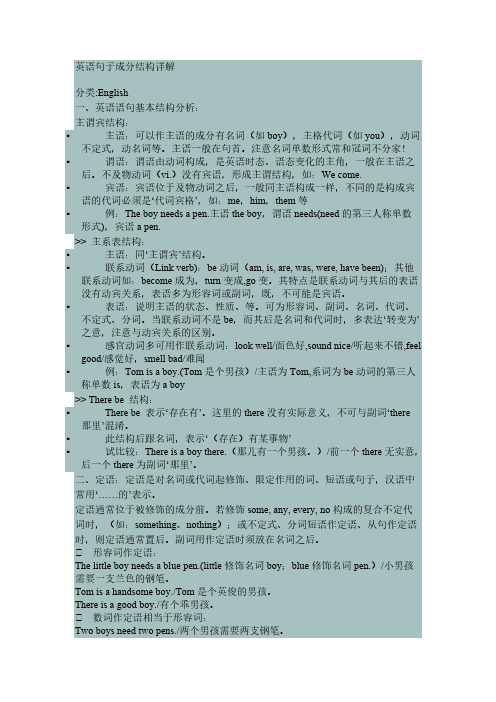
英语句子成分结构详解分类:English一、英语语句基本结构分析:主谓宾结构:▪主语:可以作主语的成分有名词(如boy),主格代词(如you),动词不定式,动名词等。
主语一般在句首。
注意名词单数形式常和冠词不分家!▪谓语:谓语由动词构成,是英语时态、语态变化的主角,一般在主语之后。
不及物动词(vi.)没有宾语,形成主谓结构,如:We come.▪宾语:宾语位于及物动词之后,一般同主语构成一样,不同的是构成宾语的代词必须是‘代词宾格’,如:me,him,them等▪例:The boy needs a pen.主语the boy,谓语needs(need的第三人称单数形式),宾语a pen.>> 主系表结构:▪主语:同‘主谓宾’结构。
▪联系动词(Link verb):be动词(am, is, are, was, were, have been);其他联系动词如:become成为,turn变成,go变。
其特点是联系动词与其后的表语没有动宾关系,表语多为形容词或副词,既,不可能是宾语。
▪表语:说明主语的状态、性质、等。
可为形容词、副词、名词、代词、不定式、分词。
当联系动词不是be,而其后是名词和代词时,多表达‘转变为’之意,注意与动宾关系的区别。
▪感官动词多可用作联系动词:look well/面色好,sound nice/听起来不错,feel good/感觉好,smell bad/难闻▪例:Tom is a boy.(Tom是个男孩)/主语为Tom,系词为be动词的第三人称单数is,表语为a boy>> There be 结构:▪There be 表示‘存在有’。
这里的there没有实际意义,不可与副词‘there 那里’混淆。
▪此结构后跟名词,表示‘(存在)有某事物’▪试比较:There is a boy there.(那儿有一个男孩。
)/前一个there无实意,后一个there为副词‘那里’。
英语句子结构剖析(9)
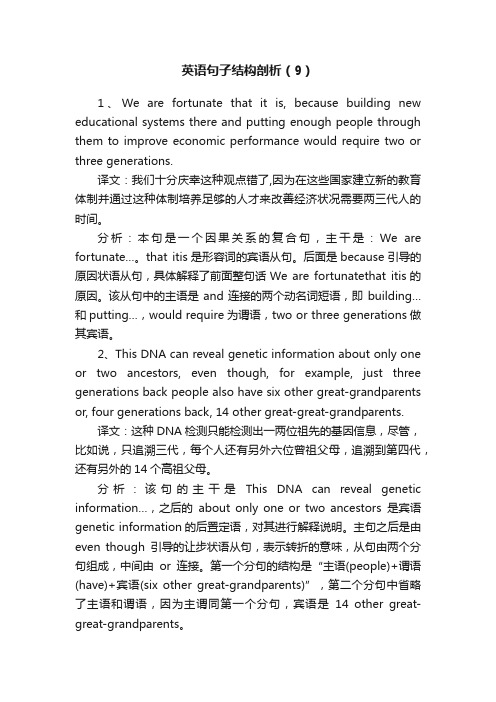
英语句子结构剖析(9)1、We are fortunate that it is, because building new educational systems there and putting enough people through them to improve economic performance would require two or three generations.译文:我们十分庆幸这种观点错了,因为在这些国家建立新的教育体制并通过这种体制培养足够的人才来改善经济状况需要两三代人的时间。
分析:本句是一个因果关系的复合句,主干是:We are fortunate…。
that itis是形容词的宾语从句。
后面是because引导的原因状语从句,具体解释了前面整句话We are fortunatethat itis的原因。
该从句中的主语是and连接的两个动名词短语,即building…和putting…,would require为谓语,two or three generations做其宾语。
2、This DNA can reveal genetic information about only one or two ancestors, even though, for example, just three generations back people also have six other great-grandparents or, four generations back, 14 other great-great-grandparents.译文:这种DNA检测只能检测出一两位祖先的基因信息,尽管,比如说,只追溯三代,每个人还有另外六位曾祖父母,追溯到第四代,还有另外的14个高祖父母。
分析:该句的主干是This DNA can reveal genetic information…,之后的about only one or two ancestors是宾语genetic information的后置定语,对其进行解释说明。
英语句子结构完美解释共33页

31、别人笑我太疯癫,我笑他人看不 穿。(名 言网) 32、我不想听失意者的哭泣,抱怨者 的牢骚 ,这是 羊群中 的瘟疫 ,我不 能被它 传染。 我要尽 量避免 绝望, 辛勤耕 耘,忍 受苦楚 。我一 试再试 ,争取 每天的 成功, 避免以 失败收 常在别 人停滞 不前时 ,我继 续拼搏 。
谢谢你的阅读
❖ 知识就是财富 ❖ 丰富ቤተ መጻሕፍቲ ባይዱ的人生
71、既然我已经踏上这条道路,那么,任何东西都不应妨碍我沿着这条路走下去。——康德 72、家庭成为快乐的种子在外也不致成为障碍物但在旅行之际却是夜间的伴侣。——西塞罗 73、坚持意志伟大的事业需要始终不渝的精神。——伏尔泰 74、路漫漫其修道远,吾将上下而求索。——屈原 75、内外相应,言行相称。——韩非
33、如果惧怕前面跌宕的山岩,生命 就永远 只能是 死水一 潭。 34、当你眼泪忍不住要流出来的时候 ,睁大 眼睛, 千万别 眨眼!你会看到 世界由 清晰变 模糊的 全过程 ,心会 在你泪 水落下 的那一 刻变得 清澈明 晰。盐 。注定 要融化 的,也 许是用 眼泪的 方式。
35、不要以为自己成功一次就可以了 ,也不 要以为 过去的 光荣可 以被永 远肯定 。
英语句子成分详解

英语句子成分详解英语句子成分详解句子是按照一定的语法规律组成的,表达一个完整的意义。
一个句子一般由两部分构成,即主语部分和谓语部分,这两部分也叫做句子的主要成分。
句子的次要成分包括宾语,定语,状语,表语、同位语等。
一.主语:主语(subject) 是一个句子的主题( theme),是句子所述说的主体、对象。
它的位置一般在一句之首。
可用作主语的有一个单词、短语、“疑问词+不定式”、从句等。
1.名词作主语。
如:A tree has fallen across the road. (一棵树倒下横在路上。
)Little streams feed big rivers. ( 小河流入大江。
)2.代词用作主语。
如:He told a joke but it fell flat. (他说了个笑话,但没有引人发笑) Everybody enjoyed themselves on vacation. 假期里大家都过得很愉快。
3.数词用作主语。
如:Three is enough. 三个就够了。
Four from seven leaves three. 7减4余3。
4.名词化的形容词用作主语。
The old and the young are taken good care of in that village.5.副词用作主语(极少见)。
如:Now is the time. 现在是时候了。
6.名词化的介词作主语。
如:The ups and downs of life must be taken as they come.我们必须承受人生之沉浮。
7.不定式用作主语。
如:To find your way can be a problem.你能否找到路可能是一个问题。
It is impossible to defeat a person who never gives up.要打败一个永不放弃的人是不可能的。
8.动名词用作主语。
小学英语语法之句子结构分析详解
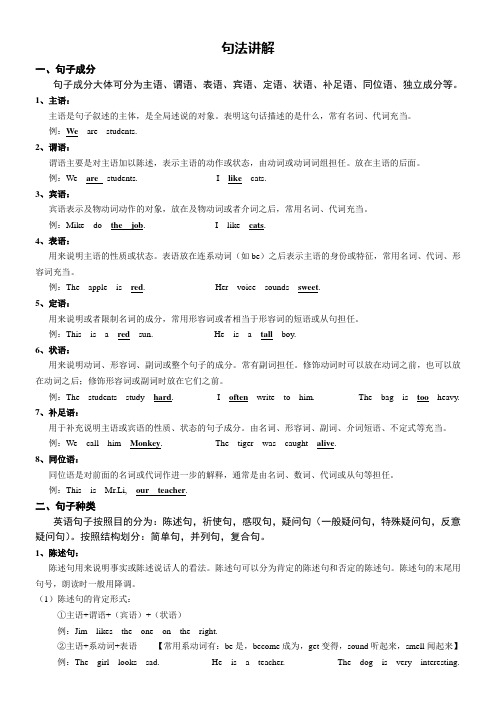
句法讲解一、句子成分句子成分大体可分为主语、谓语、表语、宾语、定语、状语、补足语、同位语、独立成分等。
1、主语:主语是句子叙述的主体,是全局述说的对象。
表明这句话描述的是什么,常有名词、代词充当。
例:We are students.2、谓语:谓语主要是对主语加以陈述,表示主语的动作或状态,由动词或动词词组担任。
放在主语的后面。
例:We are students. I like cats.3、宾语:宾语表示及物动词动作的对象,放在及物动词或者介词之后,常用名词、代词充当。
例:Mike do the job. I like cats.4、表语:用来说明主语的性质或状态。
表语放在连系动词(如be)之后表示主语的身份或特征,常用名词、代词、形容词充当。
例:The apple is red. Her voice sounds sweet.5、定语:用来说明或者限制名词的成分,常用形容词或者相当于形容词的短语或从句担任。
例:This is a red sun. He is a tall boy.6、状语:用来说明动词、形容词、副词或整个句子的成分。
常有副词担任。
修饰动词时可以放在动词之前,也可以放在动词之后;修饰形容词或副词时放在它们之前。
例:The students study hard. I often write to him. The bag is too heavy.7、补足语:用于补充说明主语或宾语的性质、状态的句子成分。
由名词、形容词、副词、介词短语、不定式等充当。
例:We call him Monkey. The tiger was caught alive.8、同位语:同位语是对前面的名词或代词作进一步的解释,通常是由名词、数词、代词或从句等担任。
例:This is Mr.Li, our teacher.二、句子种类英语句子按照目的分为:陈述句,祈使句,感叹句,疑问句(一般疑问句,特殊疑问句,反意疑问句)。
英语独立主格结构讲解

英语独立主格结构讲解英语独立主格结构讲解独立主格结构是英语语法中的一种句子结构,用于突出或强调某一部分的信息。
它由一个名词、代词或动名词构成,加上一个修饰性的词或短语,被用来表达一个与主句相对独立的概念。
独立主格结构常常出现在独立的从句中,它可以提供额外的信息,强调特定的动作或状态。
独立主格结构的形式如下:名词/代词/动名词+ 修饰性词/短语。
下面是一些例句,用于解释和示范独立主格结构的用法:1. His arms folded, he stood there silently.(他双臂折叠,默默地站在那里。
)在这个例句中,"His arms folded"是独立主格结构,它突出了他折叠双臂的动作。
2. The sun shining brightly, we decided to go for a picnic.(阳光灿烂地照耀着,我们决定去野餐。
)"The sun shining brightly"是独立主格结构,它描述了阳光灿烂的状态。
3. The rain having stopped, they continued their journey.(雨停了,他们继续他们的旅程。
)"The rain having stopped"是独立主格结构,它表示雨已经停止的状态。
4. The baby crying in the crib, she rushed to comfort him.(婴儿在婴儿床上哭,她匆忙前去安慰他。
)"The baby crying in the crib"是独立主格结构,它描述了婴儿在婴儿床上哭的动作。
需要注意的是,独立主格结构在句子中通常是非限定性的,它与主句之间存在一定的解释或补充关系。
独立主格结构可以用逗号与主句分开,但也可以使用破折号或括号等标点符号来表示。
总而言之,独立主格结构是一种用于突出或强调特定动作或状态的句子结构。
英语句子基本结构分析
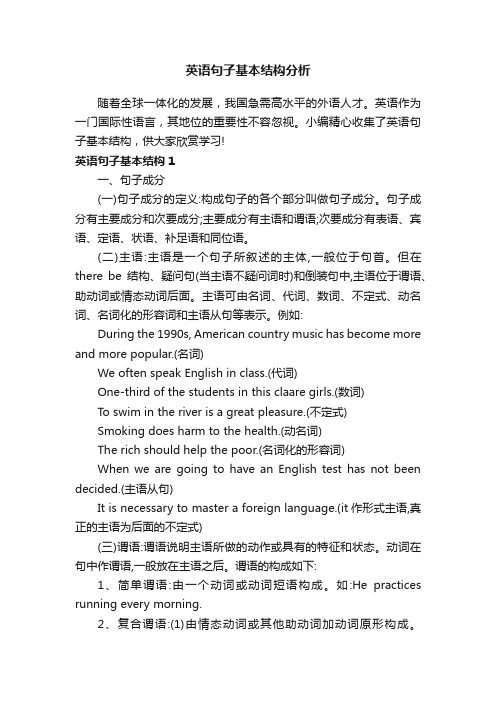
英语句子基本结构分析随着全球一体化的发展,我国急需高水平的外语人才。
英语作为一门国际性语言,其地位的重要性不容忽视。
小编精心收集了英语句子基本结构,供大家欣赏学习!英语句子基本结构1一、句子成分(一)句子成分的定义:构成句子的各个部分叫做句子成分。
句子成分有主要成分和次要成分;主要成分有主语和谓语;次要成分有表语、宾语、定语、状语、补足语和同位语。
(二)主语:主语是一个句子所叙述的主体,一般位于句首。
但在there be结构、疑问句(当主语不疑问词时)和倒装句中,主语位于谓语、助动词或情态动词后面。
主语可由名词、代词、数词、不定式、动名词、名词化的形容词和主语从句等表示。
例如:During the 1990s, American country music has become more and more popular.(名词)We often speak English in class.(代词)One-third of the students in this claare girls.(数词)To swim in the river is a great pleasure.(不定式)Smoking does harm to the health.(动名词)The rich should help the poor.(名词化的形容词)When we are going to have an English test has not been decided.(主语从句)It is necessary to master a foreign language.(it作形式主语,真正的主语为后面的不定式)(三)谓语:谓语说明主语所做的动作或具有的特征和状态。
动词在句中作谓语,一般放在主语之后。
谓语的构成如下:1、简单谓语:由一个动词或动词短语构成。
如:He practices running every morning.2、复合谓语:(1)由情态动词或其他助动词加动词原形构成。
英语句子结构详细讲解

英语句子结构详细讲解一.句子成分分析1.主语(subject)句子的主体,全句述说的对象。
一般由名词,代词,数词,不定式,动名词,从句担任,常置于句首。
(名词)(主格代词)(数词)(不定式)(动名词)(主语从句)2. 谓语(predicate)对主语加以陈述,表示主语的行为或状态,常用动词或者动词词组担任,放在主语的后面。
谓语分为简单谓语和复合谓语(1).简单谓语由一个动词或者动词短语构成at 6 o?clock.(动词)(动词短语)(2).复合谓语①由情态动词或其他助动词加动词原形构成(情态动词+动词原形)She (助动词do+动词原形)(助动词has+动词原形)补充:协助主要动词构成谓语动词词组的词叫助动词(Auxiliary Verb)。
被协助的动词称作主要动词(Main Verb)。
最常用的助动词有:be, do, have, shall, will, should, would. 助动词自身没有词义,不可单独使用,例如:He doesn't like English. 他不喜欢英语。
(doesn't是助动词,无词义;like是主要动词,有词义)②由系动词加表语构成(即主系表结构)(状态系动词be+表语)(表象系动词look+表语)补充:系动词亦称联系动词(Link Verb),作为系动词。
有些不具词义;有些具有词义,但不能单独用作谓语,后边必须跟表语(亦称补语),构成系表结构说明主语的状况、性质、特征等情况。
1.状态系动词用来表示主语状态,只有be一词,例如:He is a teacher. 他是一名教师。
(is与补足语一起说明主语的身份。
)2.持续系动词用来表示主语继续或保持一种状况或态度,主要有keep, rest, stay, lie, remain, 例如:He always kept silent at meeting. 他开会时总保持沉默。
This matter rests a mystery. 此事仍是一个谜。
英语句子结构讲解

英语句子结构句子就是按照一定得语法规律组成得,表达一个完整得意义。
一个句子一般由两部分构成,即主语部分与谓语部分,这两部分也叫做句子得主要成分。
句子得次要成分包括宾语,定语,状语,表语等。
句子成分就是句子中起一定功用得组成部分。
一.句子成分分析1. 主语(subject)句子得主体,全句述说得对象。
一般由名词,代词,数词,不定式,动名词,从句担任,常置于句首。
Professor Zhang is a famous scientist、(名词)I like football、(主格代词)Two plus five is seven、(数词)To swim in the Lijiang River is a great pleasure、(不定式)Smoking dose harm to the health、(动名词)When we are going to have an English has not been decided、(主语从句)2、谓语(predicate)对主语加以陈述,表示主语得行为或状态,常用动词或者动词词组担任,放在主语得后面。
谓语分为简单谓语与复合谓语(1)、简单谓语由一个动词或者动词短语构成The train leaves at 6 o’clock、(动词)She takes good care of her mother、(动词短语)(2)、复合谓语①由情态动词或其她助动词加动词原形构成You may keep the book for two weeks、(情态动词+动词原形)She doesn’t seem to like dancing、(助动词do+动词原形)He has caught a bad cold、(助动词has+动词原形)补充:协助主要动词构成谓语动词词组得词叫助动词(Auxiliary Verb)。
被协助得动词称作主要动词(Main Verb)。
高考英语句子结构详细剖析--

高考英语句子结构详细剖析1、People settle in these places because they are easy to get to and naturally suited to communications and trade.译文:人们在这些地方定居是因为他们很容易到达,而且很自然地适应交流和贸易。
分析:整体分析:本句可以切分为两部分,because前后分别为主句和从句。
People settle in these places 为主句。
because they are easy to get to and naturally suited to communications and trade为原因状语从句从句,从句可以切分两个分句:they are easy to get to 和and naturally suited to communications and trade,两者之间为并列关系。
重点词汇:settle in安顿下来; 在…中放稳,坐定naturally自然地,; 合理地; 天然地;不做作地suited合适的; 适合…的; 适合于; 适合,符合…的要求; 合身; 使适合communications通信; 交流( communication的名词复数);通信工具trade贸易; 行业; 买卖; 交换; 经营…交易2、Of the first 20,000 people who dug for gold, 4,000 got rich.译文:在最初的两万淘金者中,有四千人致富了。
分析:整体分析:本句可以切分为两部分,构成了主从复合句。
Of the first 20,000 people,4,000 got rich.为主句,Of the first 20,000 people为状语。
who dug for gold为定语从句修饰people.重点词汇:dug挖,掘( dig的过去式和过去分词); 挖掘; 挖得; 寻找gold金色; 金币; 黄金; 金饰品; 金色的got得到(get的过去式和过去分词); 抓住; 说服; 受到rich富有的; 肥沃的; 丰富多彩的; 油腻的3、The city was crowded with disappointed people with no interest in settling down, and when they heard there were new gold discoveries in Alaska, they left Dawson City as quickly as they had come.译文:这座城市充满了失望的人们,他们没有兴趣定居下来,当他们听说阿拉斯加有新的黄金发现时,他们很快地离开了道森城,就像他们很快地来到这里一样。
英语句子成分(1)讲解

4 就是一个谓语,动作型的谓语。 我是英语老师。这里“是英语老师”就说明了主语“我”是什么,所以“是英语老师”是谓语,状态型的谓语。 ★在英语里面也一样 例如: I eat an apple everyday. Eat 就是谓语,动作型的谓语。 I am an English teacher. am an English teacher 就是谓语,状态型的谓语。 动作型的谓语就是由动词构成的。 状态型的谓语就是由“系表结构”构成的。 ★注意:谓语只跟主语有关系,说明主语的情况,跟其他成分没有任何关系。 (一)动作型的谓语 动作型的谓语就是由动词构成的。我们来了解一下动词。 动词的定义:表示动作或心理行为的词语。很多人知道表示动作,但是忽略了心理行为。 表示动作的词语:eat 、drink、 play、 buy ...... 表示心理的词语:think、like、hate、 hope、miss...... 1、简单谓语(由“实义动词/动词短语”构成) 实义动词:就是表示有实际意义的动词。用来区别系动词、助动词、情态动词。 动词短语:就是由动词和另一个单词或者几个单词构成的词组,动词短语虽然有几个词语组成,但是只表示一个动作。 例如:look after look for look at listen to get up 短语动词相当于一个动词的作用。 例如: I love you. Love 是主语 I 发出的动作。 I speak English. Speak 是主语 I 发出的动作。 She looks after her brother. I get up at 6 o'clock. Get up 说明主语I 的都动作。 I cook fish everyday. He teaches English everyday. 2、复合谓语(就是由简单谓语加上其他的词语,共同作谓语的情况) ①情态动词+实义动词/动词短语的原形 1、 I can speak Chinese. 加个can 构成复合谓语。 2、 I can look after her. can 就是一个情态动词, can speak 和 can look after 都是复合宾语。 ②助动词(没有意义的)+实义动词/动词短语原形 例如: 1、I will buy a book tomorrow. (一般将来时) 2、I will get up early tomorrow.
(完整版)英语句子结构分析讲解

(完整版)英语句子结构分析讲解定义:构成句子的各个部分叫做句子成分。
句子成分有主要成分和次要成分;主要成分:主语和谓语次要成分:表语、宾语、定语、状语、补足语、同位语I met my best friend Tom at the station yesterday .主语谓语定语宾语同位语状语㈠主语(subject)句子说明的人或事物Jane is good at playing the piano.(名词)She went out in a hurry.(代词)Four plus four is eight.(数词)To see is to believe.(不定式)Smoking is bad for health.(动名词)The young should respect the old.(名词化的形容词)What he has said is true. (句子)找出下列句中的主语:1、The sun rises in the east.2、Twenty years is a short time in history.3、The poor are now living in the shelter.4、Seeing is believing.5、To see is to believe.6、He likes dancing.7、What he needs is a book.8、It is very clear that the elephant is round and tall likea tree. ㈡谓语说明主语的动作、状态和特征简单谓语:由动词或动词词组组成I saw the flag on the top of the hill?He looked after two orphans.复合谓语:由情态动词或助动词+动词;He can speak English well.She doesn’t seem to like dancing.找出下列句中的谓语(注:只有动词才可作谓语。
英语语句基本结构分析

英语语句基本结构分析英语语句基本结构分析英语语法是针对英语语言进行研究后,系统地总结归纳出来的一系列语言规则。
英语语法的精髓在于掌握语言的使用。
下面店铺为大家带来英语语句基本结构分析,希望大家喜欢!一、英语语句基本结构分析(一)主谓宾结构:1、主语:可以作主语的成分有名词(如boy),主格代词(如you),数词,动词不定式,动名词等。
主语一般在句首。
注意名词单数形式常和冠词不分家!eg: The boy comes from America.He made a speech.Tow and tow is four.To be a teacher is my dream.Doing a research is a necessary step of covering a story.2、谓语:谓语由动词构成,是英语时态、语态变化的主角,一般在主语之后。
谓语可以是不及物动词(vi.)没有宾语,形成主谓结构,eg:We come.Many changes took place in my home town.注(以下这些词是不及物动词:表发生、出现的,如:take place,appear, happen, break out;表来、去,如:come, go 等)3、宾语:宾语位于及物动词之后,一般同主语构成一样,不同的是构成宾语的代词必须是‘代词宾格’,如:me,him,them等。
除了代词宾格可以作宾语外,名词,动名词,不定式等可以作宾语。
eg:I will do it tomorrow.The boy needs a pen.I like swimming.I like to swim this afternoon.(二)主系表结构:1、主语:同‘主谓宾’结构。
2、谓语:联系动词(Link verb):be动词(am,is,are,was,were,have been);其他联系动词如:become成为,turn变成,go变和感官动词如:feel, touch, hear, see等。
英语句子成分讲解清晰版
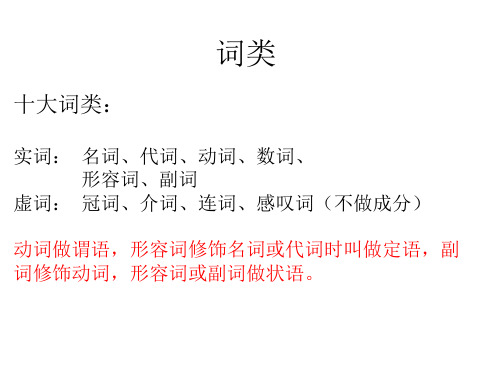
七)宾语补足语。英语有些及物动词,除了 要有宾语之外,还要加上宾语补足语,才能 使句子的意义完整。 1. They elected me captain of the team. 名词 2. We try to make our country strong. 形容词 3. We found everything in good order there. 介词短语 4. I should advise you to get the chance. to do 不定式 5. I saw him going upstairs. 现在分词 doing 6. They found the house broken in. done 过去分词
(四)宾语 表示动作的对象,是动作的承受者。 动词/动词短语 介词 词后也 宾语一般放在___________ 之后。_____ 会跟宾语。 1. She covered her face with her hands. 名词 n 2. We haven't seen her for a long time. 代词 pron 3. Do you mind opening the window? 动名词 4. Give me four please. 代词和数词 5. He wants to dream a nice dream. to do不定式 6. We need know what others are doing. 句子 7. We should care more about our friends.
宾语和宾语补足语一起构成动词的
复合结构
八)主语补足语 如果上述结构变成被动语 态,原宾语成为主语,原宾语补足语相应地 变为主语补足语 1. I was elected captain of the team. 2. Our country will be made strong. 与宾语补足语一样
高考英语 句子结构详细剖析
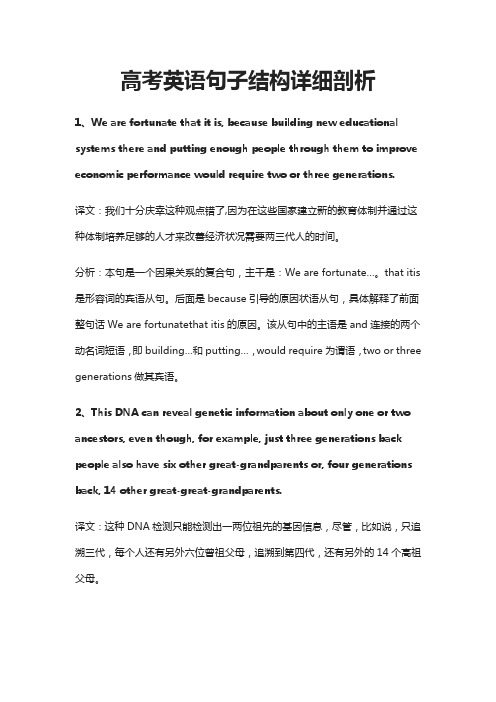
高考英语句子结构详细剖析1、We are fortunate that it is, because building new educational systems there and putting enough people through them to improve economic performance would require two or three generations.译文:我们十分庆幸这种观点错了,因为在这些国家建立新的教育体制并通过这种体制培养足够的人才来改善经济状况需要两三代人的时间。
分析:本句是一个因果关系的复合句,主干是:We are fortunate…。
that itis 是形容词的宾语从句。
后面是because引导的原因状语从句,具体解释了前面整句话We are fortunatethat itis的原因。
该从句中的主语是and连接的两个动名词短语,即building…和putting…,would require为谓语,two or three generations做其宾语。
2、This DNA can reveal genetic information about only one or two ancestors, even though, for example, just three generations back people also have six other great-grandparents or, four generations back, 14 other great-great-grandparents.译文:这种DNA检测只能检测出一两位祖先的基因信息,尽管,比如说,只追溯三代,每个人还有另外六位曾祖父母,追溯到第四代,还有另外的14个高祖父母。
分析:该句的主干是This DNA can reveal genetic information…,之后的about only one or two ancestors是宾语genetic information的后置定语,对其进行解释说明。
(完整版)英语句子结构分析讲解
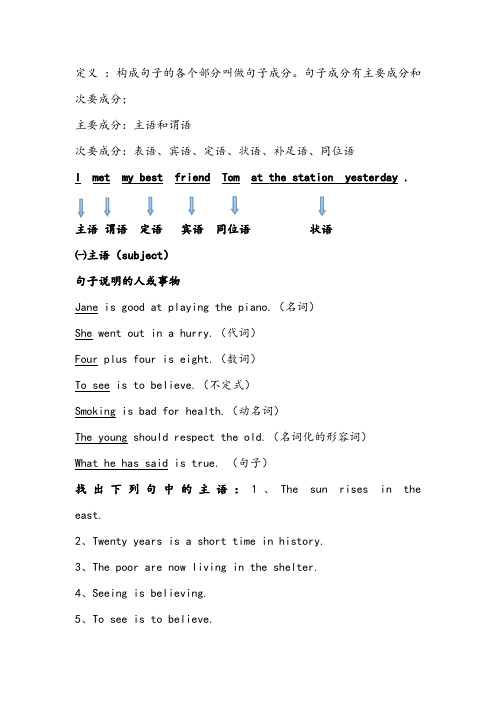
定义:构成句子的各个部分叫做句子成分。
句子成分有主要成分和次要成分;主要成分:主语和谓语次要成分:表语、宾语、定语、状语、补足语、同位语I met my best friend Tom at the station yesterday .主语谓语定语宾语同位语状语㈠主语(subject)句子说明的人或事物Jane is good at playing the piano.(名词)She went out in a hurry.(代词)Four plus four is eight.(数词)To see is to believe.(不定式)Smoking is bad for health.(动名词)The young should respect the old.(名词化的形容词)What he has said is true. (句子)找出下列句中的主语:1、The sun rises in the east.2、Twenty years is a short time in history.3、The poor are now living in the shelter.4、Seeing is believing.5、To see is to believe.6、He likes dancing.7、What he needs is a book.8、It is very clear that the elephant is round and tall likea tree. ㈡谓语说明主语的动作、状态和特征简单谓语:由动词或动词词组组成I saw the flag on the top of the hill?He looked after two orphans.复合谓语:由情态动词或助动词+动词;He can speak English well.She doesn’t seem to like dancing.找出下列句中的谓语(注:只有动词才可作谓语。
英语句子结构完美解释
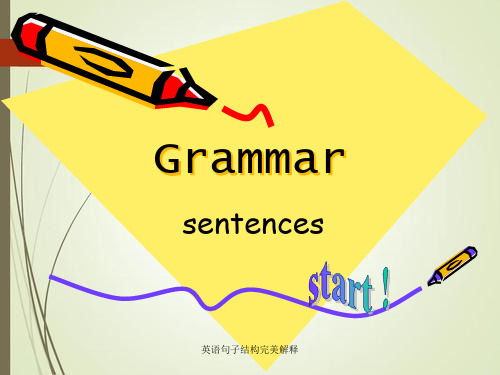
英语句子结构完美解释
Ⅱ.并列句
This is me and these are my friends. They must stay in water, or they will die. It’s not cheap, but it is very good. It was late, so I went to bed. He knocked at the door; there was no answer. You’re alive! And she’s dead.
The(black) bike is mine.
英语句子结构完美解释
说明1:当定语修饰不定代词如:nothing , anything , everything , something 等时,定语要放在其后作后置定语 我告诉他一些有趣的事情。 I tell him something interesting . 说明2:不定式、短语或从句作定语时,也放在被修饰的名词之后。 这间屋子里的男孩子们是10班的。 The boys in the room are in Class Ten.
英语句子结构完美解释
7) 状语(adverbial)
用以修饰adj. /v. /adv.及全句,位置灵活。通常在句子基本结构 之后,强调时放在句首; 修饰形容词或副词时,通常位于被修饰的词之前; 表示时间、地点、目的的状语一般位于句子两头,强调时放在句 首, 一些表示不确定时间(如:often)或程度(如:almost)的副 词状语通常位于be动词、助动词、情态动词之后,动词之前。
1) 时间状语从句 Wait until you are called. When spring came, leaves turn green.
英语句子成分和英语句子结构讲解
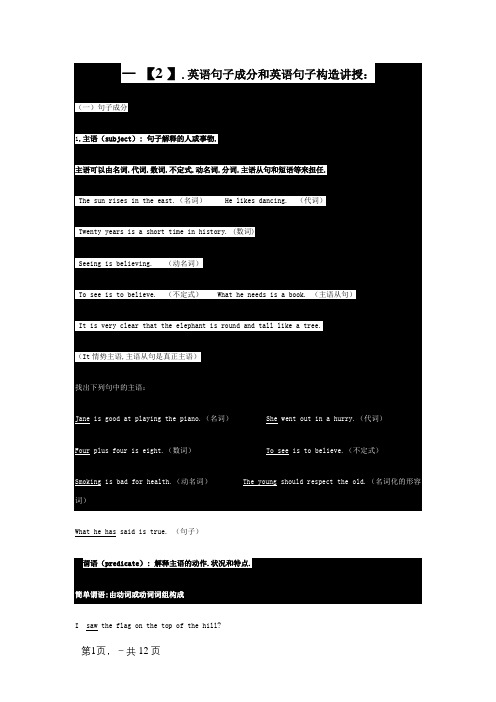
一【2 】.英语句子成分和英语句子构造讲授:(一)句子成分1.主语(subject): 句子解释的人或事物.主语可以由名词.代词.数词.不定式.动名词.分词.主语从句和短语等来担任.The sun rises in the east.(名词) He likes dancing. (代词)Twenty years is a short time in history. (数词)Seeing is believing. (动名词)To see is to believe. (不定式) What he needs is a book. (主语从句)It is very clear that the elephant is round and tall like a tree.(It情势主语,主语从句是真正主语)What he has said is true. (句子)2.谓语(predicate): 解释主语的动作.状况和特点.I saw the flag on the top of the hill?He looked after two orphans.复合谓语:由情态动词或助动词+动词;He can speak English well.She doesn’t seem to like dancing.找出下列句中的谓语(注:只有动词才可作谓语.):1. We love China.2. We have finished reading this book.3. He can speak English.4. She seems tired.3.表语(predicative): 系动词之后的成分,表示主语的性质.状况和特点.He is a teacher. (名词) Seventy-four! You don’t look it. (代词)Five and five is ten. (数词) He is asleep. (形容词)His father is in. (副词) The picture is on the wall. ( 介词短语)My watch is gone / missing / lost. (形容词化的分词)To wear a flower is to say “I’m poor, I can’t buy a ring. (不定式)The question is whether they will come. (表语从句)★(常见的系动词有: be, sound(听起来), look(看起来), feel(摸起来,smell(闻起来), taste(尝.吃起来), remain(保持,仍是), feel(感到) ...It sounds a good idea. The sound sounds strange.Her voice sounds sweet. Tom looks thin.The food smells delicious. The food tastes good.The door remains open. Now I feel tired.找出下列句中的表语.1. I am a teacher.2. They are on the playground.3. My job is teaching English.4. It gets cold.5. It sounds interesting.4.宾语:1)动作的推却者-----I like China. (名词) He hates you. (代词)How many do you need? We need two. (数词)We should help the old and the poor. I enjoy working with you. (动名词)I hope to see you again. (不定式) Did you write down what he said? (宾语从句)2)介词后的名词.代词和动名词-----介宾Are you afraid of the snake? Under the snow, there are many rocks.3)双宾语-----间宾(指人)和直宾(指物)宾语分为直接宾语和间接宾语.直接宾语指物或事,间接宾语指人或动物.He gave me a book yesterday. Give the poor man some money.指出下面句子的间接宾语和直接宾语:please pass me the book.He bought his girlfriend some flowers.找出下列句子的宾语部分:1. We often help him.2. He likes to play basketball.3. We enjoy listening to the music.4. She said that he felt sick.5. They are talking about the new student.5.宾补:对宾语的补充,全称为宾语补足语.We elected him monitor. (名词) We all think it a pity that she didn’tcome here. (名)We will make them happy. (形容词) We found nobody in. ( 副词 )Please make yourself at home. 介词短语)Don’t let him do that. (省to不定式)His father advised him to teach the lazy boy a lesson. (带to不定式)Don’t keep the lights burni ng. (如今分词)I’ll have my bike repaired. (曩昔分词)6.主补:对主语的补充,全称为主语补足语.He was elected monitor. She was found singing in the next room.He was advised to teach the lazy boy a lesson.7.定语:润饰或限制名词或代词的词.词组或句子.Ai Yanling is a chemistry teacher.(名词) He is our friend. (代词)We belong to the third world. (数词)He was advised to teach the lazy boy a lesson.(形容词)The man over there is my old friend.(副词)The woman with a baby in her arms is my sister. (介词)The boys playing football are in Class 2. (如今分词)The trees planted last year are growing well now. (曩昔分词)I have an idea to do it well. (不定式)You should do everything that I do. (定语从句)定语后置:假如定语是由一个单词表示时,平日要前置.而由一个词组或一个句子表示时,平日则后置The girl in red is his sister.We have a lot of work to do.The girl standing under the tree is his daughter.Do you know the man who spoke just now?8.状语:用来润饰v., adj., adv., 或句子.表示时光.地点.原因.成果.程度.前提.方法和妥协. (以下例句按上述次序分列)I will go there tomorrow.The meeting will be held in the meeting-room.The meat went bad because of the hot weather.He studies hard to learn English well.He didn’t study hard so that he failed in the exam. I like some of you very much.If you study hard, you will pass the exam. He goes to school by bike.Though he is young, he can do it well.(二)句子构造简单句的五个根本句型1.主语+不及物动词 She came./ My head aches.2.主语+及物动词+宾语 She likes English.3.主语+系动词+表语 She is happy.4.主语+双宾动词+间接宾语+直接宾语 She gave John a book.5.主语+宾补动词+宾语+宾语补语 She makes her mother angry.The teacher asked me to read the passage.★ There +be 句型There are some books on the desk.There lies a book on the desk.Exercises :剖析下列句子成分1. Our school is not far from my home.2. It is a great pleasure to talk with you3. All of us considered him honest.4. My grandfather bought me a pair of sports shoes.5. He broke a piece of glass.6. He made it clear that he would leave the city.翻译演习:主谓构造(主语+不及物动词)1.你应当尽力进修You should study hard.2.他昨天晚上很晚回家She went home very late yesterday evening.演习:1.This box weighs five kilos. 这个盒子重五公斤.2.I lived in Beijing five years ago. 五年前我住在北京.主谓宾构造(主语+及物动词+宾语)1.我昨晚写了一封信I wrote a letter last night.2.我今世界午想和你谈谈I want to talk with you this afternoon.演习:1.All of us believe that Jack is an honest boy. 我们大家都信任Jack 是一个说谎男孩.2.He did not know what to say. 他不知道说什麽好.主系表构造(主语+系动词+表语)1.我的弟弟都是大学生My brothers are all college students.2.在冬天,白天很短夜晚很长In winter, the days are short and the nights are long.3. 布朗密斯看上去很健康Mrs Brown looks very healthy.4.在他15岁那年他成为了有名的画家 At the age of fifteen he became a famous pianist. 演习:1、树叶已经变黄了.The leaves have turned yellow.2.这个报告听起来很有意思.The report sounds interesting.双宾语构造(主语+双宾动词+间接宾语+直接宾语)1.强森师长教师客岁叫我们德语Mr Johnson taught us German last year.2.祖父昨晚给我讲了一个有味的故事Grandma told me an interesting story last night. 演习:1. 请你给我弄一本新的,好吗? Will you please get me a new copy?2.我替你叫辆出租汽车好吗? Shall I call you a taxi?复合宾语构造(主语+动词+宾语+宾语补足语)1.我们叫她爱丽丝We call her Alice.2.他怙恃叫他约翰His parents named him John.演习:1、黉舍定了一条规矩,开端上课时学生要起立.The school made it a rule that the students should stand up when class begins. 2.我以为与那小我谈话是无益的.I thought it no use talking with that manThere be 句型1.今晚不会开会There isn’t going to be a meeting tonight.2.这个村庄里只有一口井There was only a well in the village.演习:1.铃响了.There goes the bell2.一周有七天.There are seven days a week二.英语句子种类讲授:按照句子的用处,英语句子可分为陈述句.疑问句.祈使句和感慨句.按照句子的构造,英语句子可分为简单句.并列句和复合句.中考对句子的考核重要分散在以下几个方面:1. 陈述句的构成情势及根本用法;2. 祈使句的构成情势及根本用法;3. 一般疑问句.特别疑问句.选择疑问句.反意疑问句的构成情势及根本用法;4. 由what, how引诱的感慨句的构成情势.用法及差别对于各类从句的用法我们在后面分离阐述.(一.) 陈述句的构成情势及根本用法1. 陈述句:陈述句是用来陈述一个事实或表达措辞人意见(包括确定和否认)的句子.平日用降调,句末用句号“.”.Tom has a new car.The flower isn’t beautiful.2. 陈述句否认式的构成(1) 假如确定陈述句的谓语部分含有助动词.情态动词或连络动词be,则只需在这些动词后加not即可构成否认式.He is playing the guitar.(确定)He is not playing the guitar.(否认)We can get there before dark.(确定)We can’t get thee before dark.(否认)(2) 假如陈述句的谓语动词是实义动词,而个中又没有情态动词或助动词时,则需依据人称和时态在该实义动词前加don’t, doesn’t或didn’t.同时把该实义动词变为本相.He plays the violin well.(确定)He doesn’t play the violin well.(否认)She won the game.(确定)She didn’t win the game.(否认)(3) 假如句子是there be构造或曰语动词是have(有),除了be和have之后加not之外,句中假如有some要变为any.例如:There is some wate r in the cup. →There is not any water in the cup.He has some books. →He has not any books.(4) 除not以外,否认词no, never, nothing, nobody, few等也可构成否认句.例如:There is something wrong with his bike. →There is nothing wrong with his bike.I have seen the film. →I ha ve never seen the film.(二.) 祈使句的构成情势及根本用法祈使句是用来表示敕令.请求.建议.号令等的句子,谓语动词用本相,句末用感慨号“!”或句号“.”.朗读时一般用降调.1.确定的祈使句:(1)祈使句主语是you时,you常省略,但假如要特别强调对方或表达某种强烈的情感时可以有主语或称呼语.Be quiet.You be quiet!(2)“Do+祈使句”表示一种强烈的情感或请求,do起强调感化.Do come back at once! Do be careful.(3)please用在祈使句中可以表示一种虚心的语气,但please用在句末时,必须用逗号与其余部分离开.Open the window, please.(4)Let引诱祈使句时,后面需跟上人称代词或称呼语,人称代词一般只用第一.第三人称.Let Jack wait a minute.Let’s go to school.(5)在祈使句中,Let’s和 Let us是有差别的.Let’s包括措辞者,而Let us不包括听话者在内.这点从反意疑问句时可显著看出.Let’s go skating, shall we?(表示内部的建议)Let us try again, will you?(表示向别人发出请求)2. 否认祈使句平日以Don’t或Never开首.其构造平日是:“Don’t(Never)+动词本相+其他成分” 例如:Don’t do that again!Never leave today’s work for tomorrow!Don’t be late next time!(三.) 一般疑问句.特别疑问句.选择疑问句.反意疑问句的构成情势及根本用法1. 一般疑问句:(1)一般疑问句的确定情势一般疑问句一般是指以助动词.情态动词.be动词或have(有)开端,平日请求以yes,或no来答复的疑问句,一般疑问句读时平日用升调.Do you know Mr. Smith Can you swim?(2)一般疑问句的否认构造① 在一般疑问句的否认构造中,把副词not放在一般疑问句的主语之后.但假如用not的简单情势-n’t,则须将-n’t与一般疑问句句首的be, have,助动词或情态动词写在一路.在现实应用中,一般都采用简单式.Are you not a footb all fan?Aren’t you a football fan?Will she not like it?Won’t she like it?② 与汉语不同的是,英语一般疑问句否认构造的答语是否认照样确定,全由答语的否认或确定来决议.若答语是确定的,则用yes加确定构造;若答语是否认的,则用no加否认构造.Aren’t you a football fan? 你不是足球迷吗?Yes, I am.\ No, I am not.Won’t she like it?Yes, she will. \ No, she won’t.。
专四语法串讲3英语句子成分结构详解
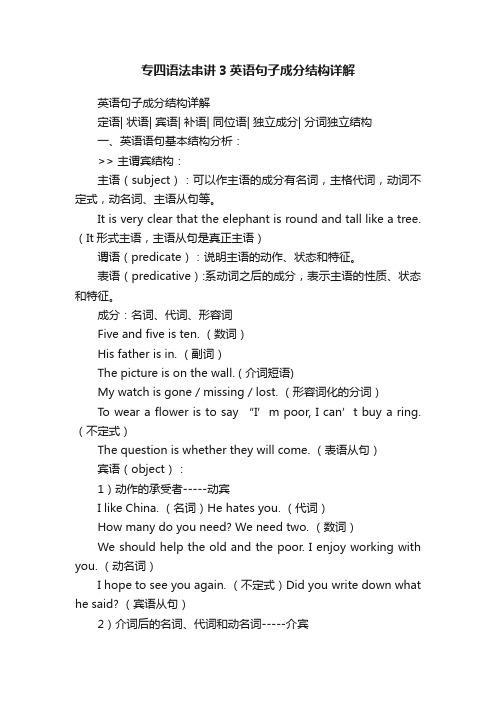
专四语法串讲3英语句子成分结构详解英语句子成分结构详解定语| 状语| 宾语| 补语| 同位语| 独立成分| 分词独立结构一、英语语句基本结构分析:>> 主谓宾结构:主语(subject):可以作主语的成分有名词,主格代词,动词不定式,动名词、主语从句等。
It is very clear that the elephant is round and tall like a tree. (It形式主语,主语从句是真正主语)谓语(predicate):说明主语的动作、状态和特征。
表语(predicative):系动词之后的成分,表示主语的性质、状态和特征。
成分:名词、代词、形容词Five and five is ten. (数词)His father is in. (副词)The picture is on the wall. ( 介词短语)My watch is gone / missing / lost. (形容词化的分词)To wear a flower is to say “I’m poor, I can’t buy a ring. (不定式)The question is whether they will come. (表语从句)宾语(object):1)动作的承受者-----动宾I like China. (名词)He hates you. (代词)How many do you need? We need two. (数词)We should help the old and the poor. I enjoy working with you. (动名词)I hope to see you again. (不定式)Did you write down what he said? (宾语从句)2)介词后的名词、代词和动名词-----介宾Are you afraid of the snake? Under the snow, there are many rocks.3)双宾语double objects-----间宾indirect object(指人)和直宾direct object(指物)有些及物动词可以有两个宾语,如:give,pass,bring,show, buy, find, fetch, get, keep, leave, lend, pass, read, save, sell, send, show, sing, take, teach, tell, throw, wish, write。
- 1、下载文档前请自行甄别文档内容的完整性,平台不提供额外的编辑、内容补充、找答案等附加服务。
- 2、"仅部分预览"的文档,不可在线预览部分如存在完整性等问题,可反馈申请退款(可完整预览的文档不适用该条件!)。
- 3、如文档侵犯您的权益,请联系客服反馈,我们会尽快为您处理(人工客服工作时间:9:00-18:30)。
7) 状语(adverbial)
用以修饰adj. /v. /adv.及全句,位置灵活。通常在句子基本结构 之后,强调时放在句首; 修饰形容词或副词时,通常位于被修饰的词之前; 表示时间、地点、目的的状语一般位于句子两头,强调时放在句 首, 一些表示不确定时间(如:often)或程度(如:almost)的副 词状语通常位于be动词、助动词、情态动词之后,动词之前。
英语句子结构完美解释
Ⅲ.复合句
名词性从句 状语从句
主语从句 表语从句 宾语从句 同位语从句
定语从句
He said that he didn’t like her. A plane is a英m语句a子c结h构i完n美e解释that can fly.
状语从句
分为九类:时间、地点、原因、结果、 目的、条件、让步、方式、程度
主 + 谓 + 宾 + 宾补
英语句子结构完美解释
Ⅱ.并列句
This is me and these are my friends. They must stay in water, or they will die. It’s not cheap, but it is very good. It was late, so I went to bed. He knocked at the door; there was no answer. You’re alive! And she’s dead.
4) 表语(predicative) 用以表述主语的特征、状态、身份等。 由n.或adj.担任。置于系动词之后。
He is a student.
英语句子结构完美解释
除了be 系动词外,还有一些动词也可以用作系动词, 1)表感官的动词:
feel, smell, taste, sound, look, appear, seem 等。 2) 表转变变化的动词: become, get, grow, turn, go,等 3)表延续的动词 remain, keep, hold, stay, rest等。
I am very sorry. We often help him. When I grow up , I am going to be a teacher .
(从句作时间状语)
英语句子结构完美解释
句子类型
简单句 并列句 复合句
英语句子结构完美解释
Ⅰ.简单句
1. Things changed.
Grammar
sentences
英语句子结构完美解释
句子成份
★ 句子一般由两个部分组成:
主语部分( subject group) 谓语部分( predicate group)
★ 句子成份: 主· 谓· 宾· 表 定· 状· 补
英语句子结构完美解释
Members of sentence: S --- subject 主· P --- predicative 表 O --- object 宾· Attri.---attribute 定· Adv.--- adverb 状·
Oc --- object complement 补
英语句子结构完美解释
1) 主语(subject) 句子的主体,全句述说的对象。一般由 名词,主格代词 ,动词不定式,动担名任词,常或置从于句句首。
I like football. The boy needs a pen.
2) 谓语(predicate) 说明主语的动作或状态。由动担词任。常置于主语后。
1) 时间状语从句 Wait until you are called. When spring came, leaves turn green.
常用的关联词有:as, after, before, since, till/ until, when, while, as soon as, whenever等
英语句子结构完美解释
Practice
Nobody went.
主+ 谓
She became a doctor.
主+ 谓 + 表
The car caught fire.
主+ 谓 +
宾
I will write you a long letter.
主 + 谓 + 间接宾语 + 直接宾语
I will let him‹go.›
The(black) bike is mine.
英语句子结构完美解释
说明1:当定语修饰不定代词如:nothing , anything , everything , something 等时,定语要放在其后作后置定语 我告诉他一些有趣的事情。 I tell him something interesting . 说明2:不定式、短语或从句作定语时,也放在被修饰的名词之后。 这间屋子里的男孩子们是10班的。 The boys in the room are in Class Ten.
英语句子结构完美解释
5) 宾补(objective complement) 补充说明宾语的情况 。 由n. /adj. /介宾 /分词 /不定式等担任。 They made him‹king.› I consider the book ‹too expensive. 6) 定语(attributive) › 对名词或代词起修饰、限定作用的词、短语或句子, 汉语中常用‘……的’表示,通常位于被修饰的成分前。
主+ 谓
2. Trees are green.
主+ 谓 + 表
3. We don’t beat children.
主+ 谓 +
宾
4. He gave his sister the piano.
主 + 谓 + 间接宾语 + 直接宾语
5. I found the book‹easy.›
主 + 谓 + 宾 + 宾补
The train leaves at 6 o’clock. I want a ticket.
英语句子结构完美解释
3) 宾语(object)
表示vt.的动作对象或prep.所联系的对象。
由n.或相当于n.的词担任。置于vt.或prep.后。
He won the game.
On the desk
Tome lost his life in the big fire.
